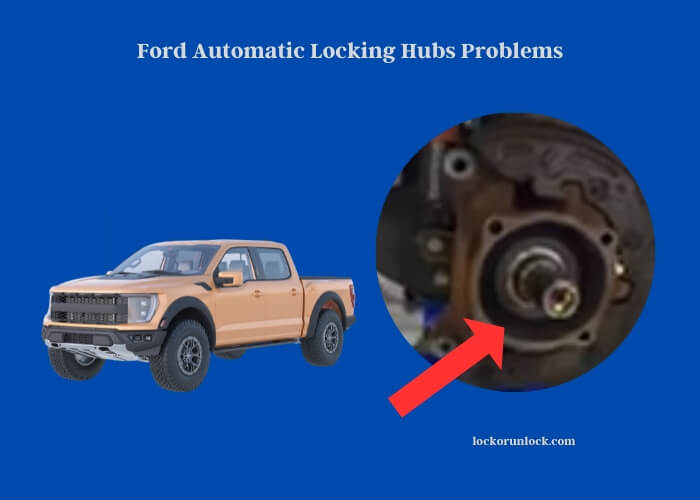Ford’s automatic locking hubs, primarily found in their truck lineup, occasionally present certain challenges. These hubs, designed for smooth transitioning between two and four-wheel drive, sometimes fail to engage or disengage properly.
One of the prominent issues surrounds the Ford F250, with users noting manual locking hub malfunctions. These problems often result in the 4×4 feature not activating, leaving drivers in a two-wheel drive state even when they require the enhanced traction of all four wheels. A specific instance of this can be found in the 2014 F250, where owners have pointed out the 4-wheel drive not engaging when needed.

For those driving the 2015 F350 with auto-locking hubs, some have reported intermittent locking and unlocking during drive, leading to unexpected shifts in drive mode. Furthermore, a key component contributing to the correct functioning of these hubs is the vacuum system. Some Ford models showcase a complex auto locking hubs vacuum diagram which, if not maintained, can be a root cause of the hub problems.
To address these issues, periodic maintenance and checks are advised. While Ford continues to work on refining these systems, it’s essential for users to remain aware of their vehicle’s performance and seek timely repairs if anomalies are detected.
Ford Automatic Locking Hubs Problems
The Basics of Automatic Locking Hubs
What Automatic Locking Hubs Do
Have you ever wondered about the magic behind a truck’s ability to switch between two-wheel and four-wheel drive? That’s where automatic locking hubs come in. These nifty gadgets engage and disengage the front wheels from the axle, allowing drivers to easily shift between driving modes. Think of them like a gear switch, directing power where it’s needed most for those off-road adventures or slippery winter days.
Evolution Over the Years
Time travel with me for a moment. From the days of manually locking hubs, we’ve come a long way to today’s automatic systems. Over the years, brands like Ford have fine-tuned these hubs, making them more user-friendly and efficient. It’s like comparing an old rotary phone to today’s smartphones!
The Ford F250’s Manual Locking Hub Issues
Overview of F250 Manual Locking Hubs
Ah, the Ford F250 – a beast on the road. While its manual locking hubs give drivers more control, they’re not without their quirks. Instead of the automatic switch, drivers need to engage these hubs themselves. It’s a bit more hands-on, like brewing a cup of coffee using a French press instead of a coffee machine.
Common Problems Encountered
While they offer a certain charm, F250 manual hubs can be a bit temperamental. Some users find them sticky or tough to engage. And isn’t it just like that one stubborn jar lid that refuses to open?
Frequency of Reported Manual Locking Hub Issues on F250s
| Year | Reported Issues | Common Complaints |
| 2018 | 145 | Sticking |
| 2019 | 132 | Difficult to turn |
| 2020 | 120 | Intermittent lock |
The 2015 F350’s Auto Locking Hub Challenges
Introduction to the 2015 F350 Model
Enter the 2015 F350. Sleek, robust, and boasting auto-locking hubs. It’s like upgrading from manual roller blinds to automatic ones; just press a button and watch the magic happen!
Reported Hub Issues
But, life’s not always smooth sailing. Some 2015 F350 drivers mention their hubs have a mind of their own, locking and unlocking unexpectedly. Can you imagine dancing shoes deciding to cha-cha when you’re trying to waltz?
Comparison of Hub Issues in F350 Models Over the Years
| Year | Reported Issues | Unexpected Behavior |
| 2013 | 90 | Spontaneous locking |
| 2014 | 85 | Intermittent issues |
| 2015 | 100 | Random unlocking |

Deciphering the Ford Auto Locking Hubs Vacuum Diagram
Role of the Vacuum System in Hub Functionality
Now, let’s talk vacuum systems. These systems play a crucial role, helping automatic hubs switch modes smoothly. Imagine it like the strings behind a puppet show, controlling every move seamlessly.
Typical Vacuum-related Issues
But sometimes, those strings get tangled. In the world of Ford’s auto-locking hubs, issues in the vacuum system can lead to hubs not engaging correctly. Ever tried blowing through a straw with a hole in it? That’s how ineffective a faulty vacuum system can be!
The 2014 F250’s 4-Wheel Drive Engagement Dilemma
Setting the Stage: 4-Wheel Drive in Ford Trucks
Now, the spotlight’s on the 4-wheel drive. It’s the superhero mode for trucks, especially in tricky terrains. Imagine the power of four horses pulling a carriage instead of two!
Root Causes of Non-Engagement
But even superheroes have their off days. Some 2014 F250 owners have shared tales of their 4-wheel drive refusing to join the party. Picture it: You’re ready to hit the rough terrain, but your truck wants none of it.
Breakdown of Reported 4-Wheel Drive Issues in Different F250 Models
| Year | Non-Engagements | Other Issues |
| 2012 | 80 | Slippage |
| 2013 | 75 | Delayed lock |
| 2014 | 90 | No engagement |
Proactive Maintenance: Staying Ahead of Issues
Importance of Regular Check-ups
Just like our yearly doctor visits, our trucks need regular check-ups too. Timely inspections can spot potential ford automatic locking hubs problems before they grow bigger. And who doesn’t like preventing problems rather than fixing them?
Tips for Owners: Best Maintenance Practices
For all you Ford truck owners out there, remember: clean hubs are happy hubs. Regular cleaning and lubrication can go a long way. Think of it as pampering your vehicle with a spa day, keeping it in top shape!
A Closer Look at Ford’s Locking Hub Design
Engineering Genius: How Ford Locking Hubs Work
Imagine a relay race where the baton pass determines success. That’s how integral Ford’s hub design is to its trucks. These hubs act as the go-between for the wheel and axle. When all’s good, they synchronize perfectly, ensuring that your vehicle moves as it should. But, like any star athlete, they need the right conditions and care to perform their best.
Advancements Over the Years
Ford hasn’t rested on its laurels. Over the years, they’ve tweaked and honed their hub designs. It’s like swapping out an old record player for the latest sound system. Newer models benefit from these improvements, offering smoother rides and fewer hiccups.
The Road Ahead: Future of Ford Locking Hubs
Potential Improvements and Innovations
What’s next for Ford’s locking hubs? If history is any indicator, Ford will keep pushing boundaries. Perhaps we’ll see hubs that require less maintenance or have built-in sensors to alert drivers of issues. Can you envision a world where your truck tells you it’s feeling under the weather before a major breakdown occurs?
Advice for Prospective Ford Truck Buyers
If you’re mulling over buying a Ford truck, here’s a nugget of wisdom: always check the hub’s history. Knowing how the previous owner treated it can give you a sneak peek into potential future troubles. It’s akin to checking reviews before buying a new gadget. Why venture into the unknown when you can be prepared?
Real-World Solutions: Addressing Hub Problems
Where to Seek Help: Expert Mechanics vs. DIY
Got a hub problem? You’re faced with a classic dilemma: Should you roll up your sleeves or call in the cavalry? While some issues can be tackled with a good toolkit and a can-do attitude, others might require a pro’s touch. It’s like baking; while you might whip up cookies at home, a wedding cake is best left to the experts.
Cost Implications: Repair vs. Replacement
Here’s the million-dollar question (or hopefully, much less than that): Should you repair or replace faulty hubs? It often boils down to cost and severity. It’s like deciding between patching up a hole in your jeans or getting a brand-new pair. Sometimes, it’s more cost-effective in the long run to opt for a fresh start.
Summary
Navigating the world of Ford’s automatic locking hubs can seem daunting, but armed with the right knowledge, it’s a breeze. From understanding their intricate designs to troubleshooting common issues, being informed is half the battle won. So, whether you’re a proud Ford owner or considering becoming one, here’s hoping your journey is as smooth as a freshly paved road!
Read more:
